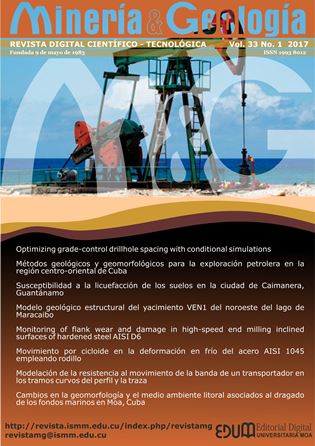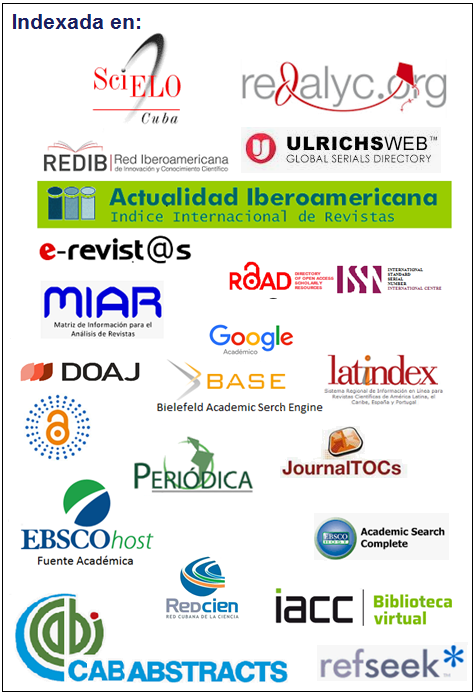Geological and geomorphological methods for petroleum prospection in the center and west of Cuba
Keywords:
petroleum exploration, hydrocarbons, gas and oil potential, geophysics, geomorphology, data interpretationAbstract
The provinces of Holguin and Las Tunas have potential gas and oil resources which have not yet been fully discovered. Therefore, an assessment is completed to identify potential areas for hydrocarbon prospection based on the geological and geomorphological methods and supported by geophysical methods. Numerous proofs of the existence of oils in the surface and gas being reported in the petroleum wells are sufficient elements to think that there is an active petroleum system in the area. The analysis is supported by information given on the geological surface maps on scale of 1:100 000, satellite and radar images, information of surface occurrence of hydrocarbons, drilled wells and recent field work and geophysical interpretation results. The main results include the identification of two areas for petroleum exploration: the Maniabón-La Farola is identified as the most potential area and the second one is to the north of the Picanes well 1x. Neotectonic processes are identified to have a strong influence on the first area, which allowed delimitating petroleum system elements through geological and geomorphological methods.Downloads
References
ÁLVAREZ, J.; SÁNCHEZ, J.; LÓPEZ, J. O.; CRUZ, R. & PROL, J. 2001: Etapa 07 proyecto 2132, Evaluación de los leads y prospectos de los bloques 12, 13, 14, 15, 16, 17, 18 y 21. Archivo Técnico CEINPET. La Habana, Cuba.
ARISMENDI, J. 2010: Uso de las imágenes Radar en Geomorfología. Curso PDVSA. Centro de Procesamiento Digital de Imágenes, Caracas, Venezuela.
CHUVIECO, E. 1995: Fundamentos de Teledetección Espacial. Ediciones Rialp S.A., Madrid, 224 p.
COTILLA, M. & CÓRDOVA, D. 2010: Study of the Cuban fractures. Geotectonics 44(2): 176–202.
CRUZ, R. 2008: Efectividad de los métodos geomorfológicos en la búsqueda de petróleo y gas desde la región de Bijabos hasta Pina. José Álvarez Castro (Tutor). Tesis de maestría. Universidad de Pinar del Río. 83 p.
ITURRALDE-VINENT, M. A. (2012). Compendio de Geología de Cuba y del Caribe. Editorial CITMATEL, La Habana.
JIMÉNEZ, L. 2015: Evaluación geólogo-geomorfológica para la búsqueda de hidrocarburos en las provincias de las Tunas y Holguín. Ramón Cruz Toledo (Tutor). Tesis de maestría. Universidad de Pinar del Río. 98 p.
LAMADRID, J. & HORTA, R. 1979: Geomorfología. Pueblo y Educación, La Habana, 166 p.
LINARES, E.; GARCÍA, D.; DELGADO, O.; LÓPEZ, G. & STRAZHEVICH, V. 2011: Yacimientos y manifestaciones de hidrocarburos de la República de Cuba. Editorial Palcogra, La Habana, 488 p.
LÓPEZ, O.; TOIRAC, R.; MORALES, C.; PERERA, C.; MARTÍNEZ, E.; GONZÁLEZ, D.; CASTRO, O.; OTERO, R. & RODRÍGUEZ, R. 2010: Informe del pozo Picanes 1x. Archivo Técnico CEINPET. La Habana. Cuba.
PÉREZ, Y.; CRUZ, R.; JIMÉNEZ, L.; PÉREZ, M. V.; VALDIVIA, C.; MARTÍNEZ, E. & RODRÍGUEZ, O. 2013: Informe anual de avances en los criterios exploratorios en el año 2013. Proyección puntualizada del plan de exploración del año 2014. Archivo Técnico CEINPET. La Habana, Cuba.
VALDIVIA, C.; VEIGA. C.; MARTÍNEZ, E.; DELGADO, O.; DOMÍNGUEZ, Z.; PARDO, M.; JIMÉNEZ, L.; CRUZ, T.; GÓMEZ, J.; ROSELL, Y. & RODRÍGUEZ, O. 2015: Informe de resultados de la evaluación del potencial de hidrocarburos del Bloque 17. Archivo Técnico CEINPET. La Habana, Cuba.
Published
How to Cite
Issue
Section
- Authors retain copyright and guaranteeing the right magazine to be the first publication of the work as licensed under a Creative Commons Attribution-NonCommercial that allows others to share the work with an acknowledgment of the work's authorship and initial publication in this journal.
- Authors may establish separate supplemental agreements for the exclusive distribution version of the work published in the journal (eg, place it in an institutional repository or publish it in a book), with an acknowledgment of its initial publication in this journal.
- Authors are allowed and recommended to disseminate their work through the Internet (e.g., in institutional telematic archives or on their websites) before and during the submission process, which can produce interesting exchanges and increase citations of the published work. (See The effect of open access)




